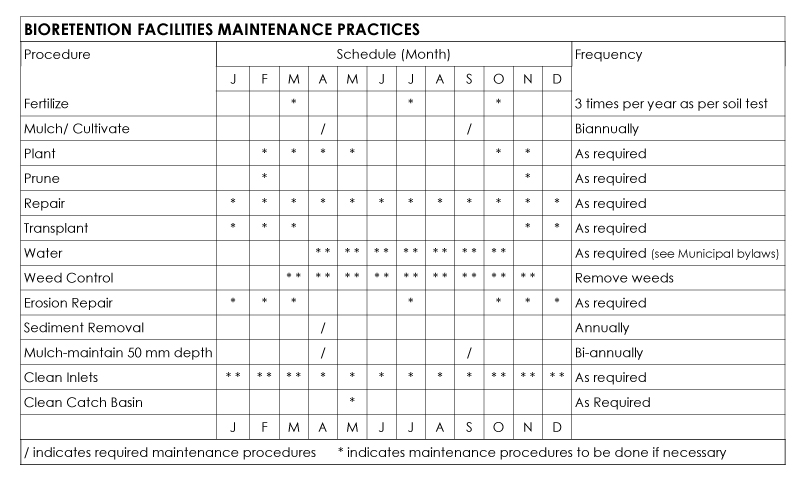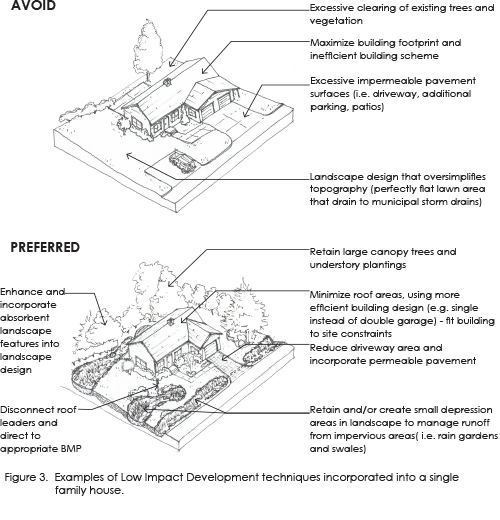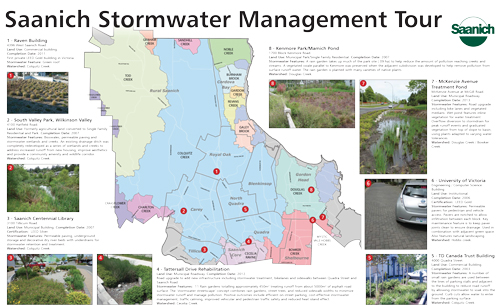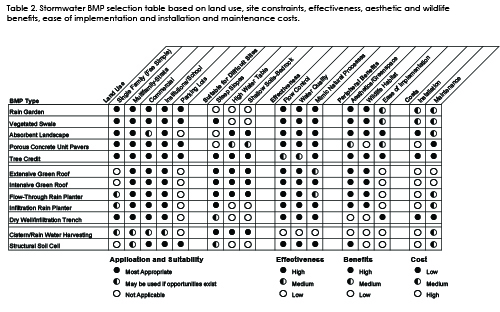
Stormwater Management
Stormwater is the runoff of rain water, hail or snow. Stormwater management is how we design systems to treat stormwater quantity and quality.
Traditionally, Saanich used drainage systems consisting of ditches and in more developed areas, an underground network of pipes to convey runoff quickly to the nearest creek or ocean outfall. The main priority was to get the water away from roads and homes as quickly as possible.
Over time, as development occurred, paved or built surfaces (impervious surfaces) have increased, reducing the surface area available to absorb rainfall. Some of our more developed local areas in Saanich have over one third impervious surfaces now.
With more impervious surfaces, these urbanized areas generate a greater volume of more polluted runoff. As the water travels across road surfaces it picks up pollutants such as gasoline, motor oil, heavy metals, sediment and solid waste. Runoff from home sites and roofs can contain pathogens, fertilizers and other chemicals. These pollutants are carried to local creeks and waterways, including places where people may be boating or swimming or streams with wild salmon and trout populations. The increased volume of runoff also poses problems for flooding and for erosion of streambanks.
In order to address these issues, municipalities now incorporate Best Management Practices (BMPs) into their stormwater management techniques. BMPs aim to:
- Allow as much stormwater as possible to infiltrate into the ground, rather than flowing offsite.
- Reduce the total quantity of runoff.
- Filter the water leaving the site wherever possible.
We use many of these BMPs on both private and public land.
.jpg)
Douglas Creek in October 2011, before and after 4 mm of rain fell in 40 minutes. Photo by Bob Bridgeman
Stormwater Policies and Regulations
We have two main sets of rules to manage stormwater.
1 - Subdivision Bylaw:
- Find requirements on sewers and drains in Schedule H of the Subdivision Bylaw.
- Read Section 2.2.18 of the Building and Plumbing Bylaw.
2 - Stormwater Development Permit:
The Stormwater Development Permit Guideline states:
"The total impervious cover of the site should minimize impact on the receiving aquatic environment. Consideration should be given to reducing impervious cover through reduction in building footprint and paved areas and use of on-site infiltration."
The guideline applies to Institutional properties that are increasing impervious surfaces — those that do not absorb water — by 250 m2 or more.
- See the Stormwater Development Permit.
Low Impact Development

Low Impact Development (LID) is an environmentally friendly approach to land development (or re-development). Choosing this approach softens the impact that stormwater has in urban areas.
- Manage runoff as close to its source as possible.
- Think of rainwater as a resource, not a waste product.
- Promote the natural movement of water within an ecosystem or watershed.
You can apply LID to new development, re-development, or when retrofitting existing sites.
How LID Works
In technical terms it is referred to as maintaining the pre-development hydrologic regime. Among the other benefits of LID are the protection of natural systems such as wetlands, streams and forest corridors. This is done by preserving as much open space as possible through layout of streets and lots specifically to minimize the amount of land that is disturbed.
- Protect areas that naturally catch water — wetlands, streams and forest corridors.
- Disturb as little land as possible when laying out streets and lots.
- Reduce building footprints.
- Cluster developments;
- Reduce parking lot stall size where you can.
Having More Open Space Helps
- More space holds more water.
- Less stormwater leaves your development.
- You lower your stormwater management costs.
- There is more area for people to gather and play.
The stormwater techniques or Best Management Practices (BMPs) that are used employ the principle that rainwater is a resource, not a waste product and promote the natural movement of water within an ecosystem or watershed.
Some of these BMPs include rain gardens, green roofs, permeable paving and vegetated swales. Please see Stormwater Best Management Practices (below) for more details.
Best Management Practices
Stormwater Best Management Practices (BMPs) are practices that are designed to:
- Slow
- Store
- Infiltrate
- Evaporate
- Detain runoff from impervious surfaces
BMP Goals:
- Clean pollutants picked up by runoff in impervious areas.
- Absorb water back into the ground.
- Keep most runoff out of storm sewers.
- Handle small to medium sized rain storms.
During heavier precipitation, when BMPs can't handle the runoff, an overflow structure directs excess water into the municipal storm drain network.
What are some examples of BMPs?
- Rain gardens
- Vegetated swales — marshy tracts of low land
- Absorbent landscapes
- Large canopy trees
- Green roofs — extensive and intensive
- Flow-through rain planters
- Infiltration rain planters
- Infiltration trenches
How do BMPs reduce damage to our water bodies?
Disconnecting runoff from storm sewers and directing it to absorptive landscaping, swales, green roofs or raingardens, slows the runoff to urban streams and naturally filters and treats the pollutants in the water before it reaches aquatic habitat.
Choosing a Stormwater BMP
The BMPs you choose for your site will depend on many factors.
- Land use
- Site design
- Site constraints
- Budget
The table below summarizes criteria for BMPselection, and the suitability or effectiveness of specific BMPsat addressing each issue. This table can be used as a tool to assist with BMP selection.
Basic BMP Factsheets
These apply to fairly simple structures. If you build them following directions, they will manage runoff. You don’t need any other professional services.
BMP Maintenance Requirements
Regular upkeep helps facilities to work properly. Keeping them in top shape also improves water quality and prevents clogging and overflow.
Learn how to maintain your stormwater structures on the table below.

Irrigation
- Select plants which are tolerant of the bioretention facility’s particular conditions.
- Water during first 2 to 3 years to establish plants.
- After that time, water only during prolonged dry periods or once per week in the summer.
Erosion Control
Unless you have extreme weather, erosion shouldn’t be a problem.
- Inspect flow entrances, ponding area and surface overflow areas. Do this periodically.
- Replace soil, plant material and mulch in areas where erosion has occurred.
- If erosion problems do occur, the following issues should be re-assessed: flow volumes from the contributing drainage area and bioretention facility size; flow velocities and gradients within the bioretention facility.
- flow dissipation and erosion protection methods in the pretreatment and in-flow areas.
If you find sediment in the bioretention facility:
- Find the source immediately.
- Remove excess deposits.
- Correct the problem.
Plant Material
- Prune to the needs of your plants and plan’s design.
- Replace dead plants.
- If you repeatedly lose certain plants, assess the cause. You may need to change species.
- You will need to weed until your groundcover plants take hold.
- You shouldn’t need to weed that often when you have the right plant density.
Nutrients and Pesticides
The growing Medium should be selected for optimum fertility, plant establishment, and growth within the particular conditions of each bioretention facility.
- Nutrient and pesticide inputs should not be required as they will degrade the pollutant processing capability of the bioretention facility, and contribute to additional pollutant loading to receiving waters.
- Most bioretention facilities are in areas where phosphorous and nitrogen levels are already elevated.
Mulch
Soil mixes for bioretention facilities are carefully designed.
- They promote long-term fertility and can process pollutants.
- Research shows that metal accumulation in bioretention facilities will not be a concern for at least 20 years (USEPA, 2000).
- If metal deposits are likely, replace mulch as below. You’ll add an extra layer of safety.
- Analyze soil for fertility and pollutant levels if you are in doubt.
If your drainage areas include commercial or industrial uses, parking lots or roads.
- Replace mulch from the bottom of your bio-retention facilities.
- Do this to the fore-bay area twice yearly.
- You will remove heavy metal deposits.
If your site is residential or in a setting where metal deposits are not a concern.
- Maintain 5-10 cm of mulch.
- Replace or add mulch as you need to.
- Do this at least once every two years.
Resources

You'll find more information about these topics at the following websites:
Capital Regional District (CRD)
- Examples of permeable paving, rain gardens, swales and green roofs.
- How to Build a Rain Garden
- Green Stormwater Infrastructure



 [PDF - 1.4 MB]
[PDF - 1.4 MB]